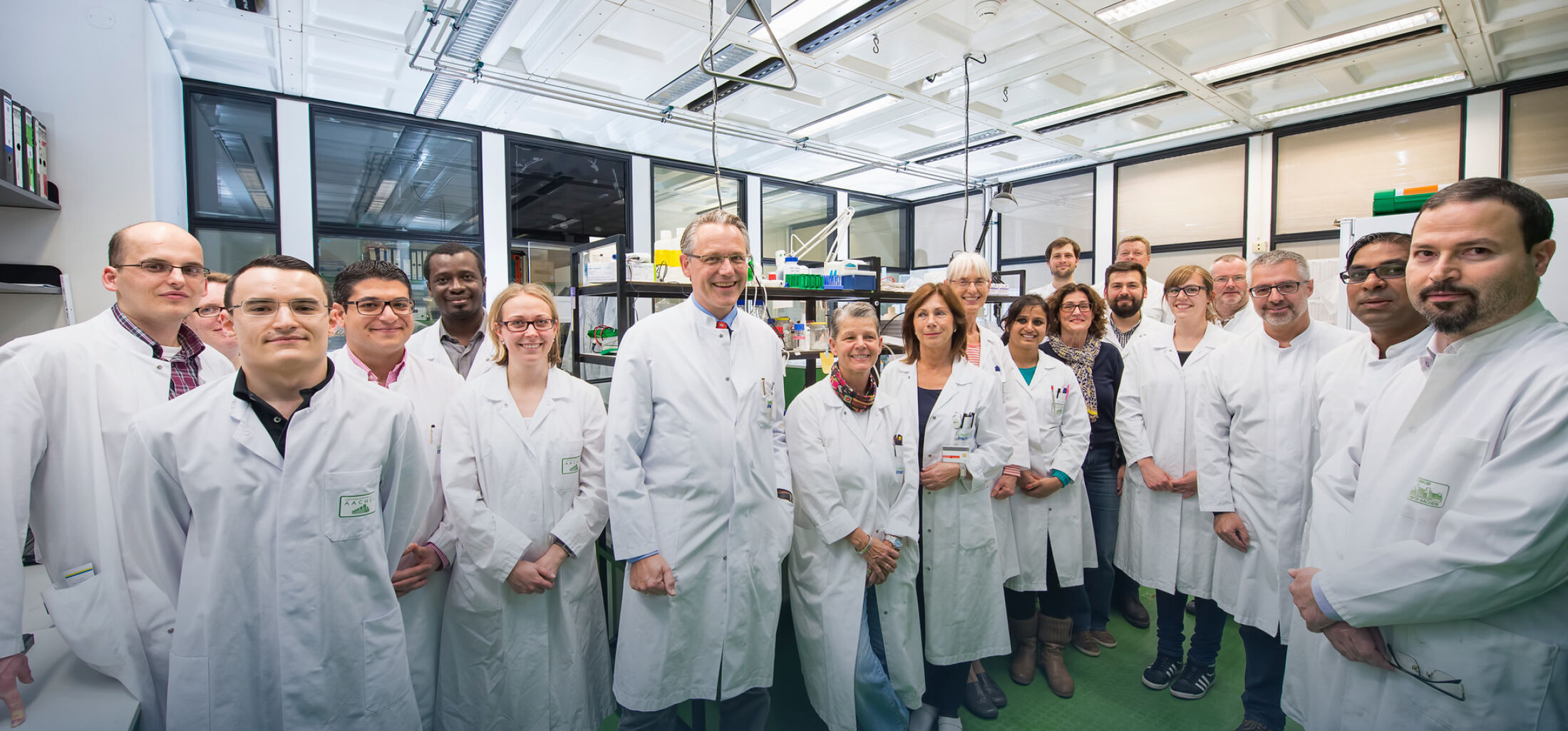Gary Brook

PD Dr. G.A. Brook, Dr. P. Achenbach – Neuroregeneration group
Main research interests
- The study of cell-substrate interactions between neural cells and bioengineered 3D matrices / scaffolds in vitro and in vivo
- Development of in vitro organotypic models to study aspects of neuronal degeneration and protection, axon regeneration and remyelination
- Development and assessment of cell- and bioengineering-based intervention strategies to promote functional tissue repair in in vivo models of traumatic nervous tissue injury (PNS and CNS)
- Investigation of foreign body response and tissue scarring when bioengineered scaffolds are used to bridge animal models PNS/CNS injury or in cases of attempted clinical repair of injured nerves
- The use of post-mortem human spinal cord samples or biopsied/resected human nerve samples for correlative investigations of lesion-induced changes in experimental animal tissues and in lesioned human tissues
Main teaching activities
- Master’s course in Biomedical Engineering
- Basic human anatomy and medical terminology
- Optional course in neuroscience
- Practical course in immunohistochemical and histological techniques
- Cellular and Molecular Neurosciences
- Lectures, practicals and seminars in neurotraumatology and regenerative medicine
- Anatomy of the nervous system for Neurotechnology and Neuroengineering MSc students
- Internships are available for students interested in developing laboratory experience associated with the themes of neuroregeneration and biomaterials.
Selected original articles
- Achenbach P, Altinova H, Brook GA. (2024) Substrate topography as a powerful tool to modify glial cell biology and interactions. Neural Regen Res. 20(5): 1390-1391.
- Achenbach P, Hillerbrand L, Gerardo-Nava JL, Dievernich A, Hodde D, Sechi AS, Dalton PD, Pich A, Weis J, Altinova H, Brook GA. (2023) Function Follows Form: Oriented Substrate Nanotopography Overrides Neurite-Repulsive Schwann Cell-Astrocyte Barrier Formation in an In Vitro Model of Glial Scarring. Nano Lett. 23(14): 6337-6346
- Altinova H, Achenbach P, Palm M, Katona I, Hermans E, Clusmann H, Weis J, Brook GA. (2022) Characterization of a Novel Aspect of Tissue Scarring Following Experimental Spinal Cord Injury and the Implantation of Bioengineered Type-I Collagen Scaffolds in the Adult Rat: Involvement of Perineurial-like Cells? Int J Mol Sci. 23(6): 3221.
- Hrynevich A, Achenbach P, Jungst T, Brook GA, Dalton PD. (2021) Design of Suspended Melt Electrowritten Fiber Arrays for Schwann Cell Migration and Neurite Outgrowth. Macromol Biosci. 21(7): e2000439.
- Altinova H, Hammes S, Palm M, Achenbach P, Gerardo-Nava J, Deumens R, Führmann T, van Neerven SGA, Hermans E, Weis J, Brook GA. (2020) Dense fibroadhesive scarring and poor blood vessel-maturation hamper the integration of implanted collagen scaffolds in an experimental model of spinal cord injury. Biomed Mater. 15(1): 015012.
- Altinova H, Hammes S, Palm M, Gerardo-Nava J, Achenbach P, Deumens R, Hermans E, Führmann T, Boecker A, van Neerven SGA, Bozkurt A, Weis J, Brook GA. (2019) Fibroadhesive scarring of grafted collagen scaffolds interferes with implant-host neural tissue integration and bridging in experimental spinal cord injury. Regen Biomater. 6(2): 75-87.
- Boecker AH, Bozkurt A, Kim BS, Altinova H, Tank J, Deumens R, Tolba R, Weis J, Brook GA, Pallua N, van Neerven SGA. (2018) Cell-enrichment with olfactory ensheathing cells has limited local extra beneficial effects on nerve regeneration supported by the nerve guide Perimaix. J Tissue Eng Regen Med. 12(11): 2125-2137
- Kriebel A, Hodde D, Kuenzel T, Engels J, Brook G, Mey J. (2017) Cell-free artificial implants of electrospun fibres in a three-dimensional gelatin matrix support sciatic nerve regeneration in vivo.J Tissue Eng Regen Med. 11(12): 3289-3304.
- Hodde D, Gerardo-Nava J, Wöhlk V, Weinandy S, Jockenhövel S, Kriebel A, Altinova H, Steinbusch HW, Möller M, Weis J, Mey J, Brook GA. (2016) Characterisation of cell-substrate interactions between Schwann cells and three-dimensional fibrin hydrogels containing orientated nanofibre topographical cues. Eur J Neurosci. 43(3): 376-87.
- Ruschel J, Hellal F, Flynn KC, Dupraz S, Elliott DA, Tedeschi A, Bates M, Sliwinski C, Brook G, Dobrindt K, Peitz M, Brüstle O, Norenberg MD, Blesch A, Weidner N, Bunge MB, Bixby JL, Bradke F (2015) Axonal regeneration. Systemic administration of epothilone B promotes axon regeneration after spinal cord injury. Science 348(6232): 347-52.
- Gerardo-Nava J et al (2014) Spinal cord organotypic slice cultures for the study of regenerating motor axon interactions with 3D scaffolds. Biomaterials. 35:4288-4296
- Cantinieaux D et al., (2013) Conditioned medium from bone marrow-derived mesenchymal stem cells improves recovery after spinal cord injury in rats: an original strategy to avoid cell transplantation. PLoS One. Aug 27;8(8):e69515.
- Bozkurt A et al., (2012) The role of microstructured and interconnected pore channels in a collagen-based nerve guide on axonal regeneration in peripheral nerves. Biomaterials. 33(5):1363-75.
- Bockelmann, J., K. Klinkhammer, A. von Holst, N. Seiler, A. Faissner, A. Brook, D. Klee, and J. Mey (2011). Functionalization of Electrospun Poly(epsilon-Caprolactone) Fibers with the Extracellular Matrix-Derived Peptide GRGDS Improves Guidance of Schwann Cell Migration and Axonal Growth. Tissue Eng Part A 17:475-86
- Führmann T et al., (2010) Cell-cell interactions of human neural progenitor-derived astrocytes within a microstructured 3D-scaffold. Biomaterials. 31:7705-7715.
- Koopmans GC et al., (2009) Acute rolipram/thalidomide treatment improves tissue sparing and locomotion after experimental spinal cord injury. Experimental Neurology 216: 490-498.
Selected reviews/book chapters
- Dalton PD, O´Neill KL, Pêgo AP, Plant GW, Nisbet DR, Oudega M, Brook GA, Harvey AR (2022) Tissue Engineering of the Nervous System. In: Tissue Engineering 3rd Edition. Chapter 20. Clemens Van Blitterswijk, Jan De Boer (eds.). Academic Press - Elsevier. ISBN: 9780128244593.
- Gerardo-Nava JL, Rose JC, Altinova H, Dalton PD, De Laporte L, Brook GA (2020) Nanofibres and Nanostructured Scaffolds for Nervous System Lesions. In: Nanomedicines for Brain Drug Delivery Chapter 3, pp. 61-101. Morales JO, Gaillard PJ (eds.) Nanomedicines for Brain Springer Protocols, Springer Science+Business Media, LLC, New York
- GA Brook, D. Hodde, T Kretschmer (2014) Grundlegendes zu Degeneration und Regeneration von Nerven. In: Kretschmer, Antoniadis, Assmus (eds.). Nervenchirurgie. Springer, ISBN: 978-3-642-36895-3.
- Hodde D, Gerardo-Nava JL, Deumens R, Mey J, Brook GA (2012). Electrospinning of Nanofibres for Repair of the Injured Peripheral Nervous System. In: Nanomedicine and the Nervous System. Ed. Preedy VR. Science Publishers, New Hampshire USA.
- Deumens R et al., (2010) Repairing injured peripheral nerves: bridging the gap. Progress in Neurobiology. 92(3):245-76
